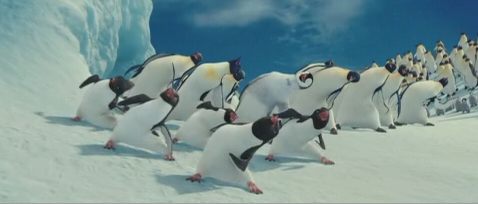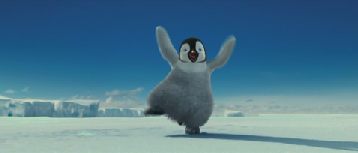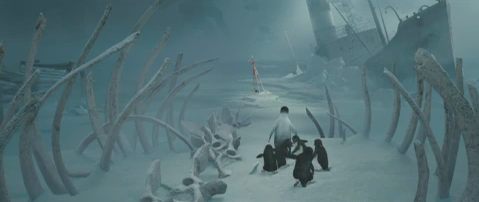Happy Feet (George Miller, 2006)
Happy Feet is a computer animated film about a free-spirited penguin, Mumble, who dances when all around him only sing. Watching it, I felt a sense of disconnection from my fellow filmgoers that matched that of its protagonist. This was a feel good dancing penguin movie, right? One which has been met by widespread audience and critical acclaim. One which, the ads insist, has “audiences floating out of the cinema on feel good clouds.” So what was the Happy Feet I saw? The film I saw was obviously well-intentioned, but it was poorly made, lamentably unmusical, and, well… depressing.
I really wanted, even expected, to like it. It’s a major Australian animated feature, which is unusual and to be welcomed, and I have tremendous respect for George Miller, whom I have always considered to be one of Australia’s most talented filmmakers. He showed with Mad Max and its sequels that he has an extraordinary feel the kinetics of cinema, and with the two Babe films* he showed he could produce a childlike whimsy in special-effects laden movies. And after all, how wrong could you go with dancing penguins?
I had assumed it would be the basic appeal of the premise that would get Happy Feet across the line. It’s a great idea for a film. Penguins are cute, they mass in large groups, and computer animation allows for really ambitious large-scale choreography. The potential for really grand, spectacular musical numbers is obvious. When I reviewed Flushed Away, I noted that the frogs in that film played on a well established type of joke in animation: groups of characters working together in improbably coordinated harmony. Happy Feet does a very similar thing. In the earliest days of sound cartoons, it was quickly realised that if you timed animation to music, and then made multiple copies of the drawings, what you ended up with was the ultimate in perfectly in-step dance lines. In effect, a quirk of the medium (that drawings can be precisely timed to music) and a labour-saving technique (reusing animation) are exploited for their aesthetic effect. Disney’s famous short The Skeleton Dance did this in 1929, and the dance sequences in Happy Feet are ultra-sophisticated variations on the same basic effect. Which is good: it’s recognising a basic property of animation – that it’s highly suited to musicals – and exploiting it.


But it doesn’t work. Firstly, the music is dull: like Moulin Rouge, it presents a fairly middle-of-the-road selection of songs that would suit a “hits and memories” radio station, yet without the earlier film’s inventiveness and spirited arrangements. There are surprisingly few proper dance numbers: the penguins sing to each other a lot, but the really big, uplifting dance spectaculars are few and far between. Those that there are, however, reveal a deeper problem, which is that Miller hasn’t really worked out how to make these penguins dance. He has assumed that the answer was to find a great tap-dancer, telling the Washington Post that he knew “even the greatest animators in the world would take a lifetime to pull off the nuances of dancing that a gifted dancer is able to pull off.” So Miller hired tap dancer Savion Glover and motion-captured his performance, transferring his movements straight into Mumble.
What this shows is a strange ignorance of – even contempt for – the form in which he’s working. Animation is all about expression through movement: animators can do so in their art-form with just as much facility as a dancer can in theirs. But of course, this isn’t a live tap performance; it’s an animated film, so surely Miller should have been talking to artists in the discipline in which he was working. To rely on a literal translation of an actual performance is to miss the potential for expressiveness beyond the capabilities of real dancer that is the particular potential of animation. (He didn’t even get an unspoiled tap performance, as the Washington Post article makes it clear he had to instruct Glover to amend his dancing to be more penguin-like). The result is a lot of pointlessly realistic penguins that aren’t terribly effective dancers – they barely have legs – and a plot that turns on a tap performance that isn’t as dynamic or exuberant as it needs to be.
Miller’s approach to animation – which is basically to super-impose realistic penguin designs onto motion-capped data, like a costume over an actor – suggests that he has made Happy Feet as an animated film only reluctantly. You feel that in his mind, he doesn’t really see this is any different to a live-action film like Babe: it just happened that instead of manipulating footage of real animals, it was easier to build them from the ground up in the computer. These are not cartoony penguins: they’ve been designed like a special effect, so that they could pass for real in a live-action film. It’s an approach the denies the possibilities of the form in which Miller is working.
Perhaps this is a dogmatic objection, only of interest for animation purists like myself. But it has to be a problem if you struggle to tell characters apart, doesn’t it? Only a handful of characters are strongly distinguished from other penguins by their design: others, including major characters such as Mumble’s parents and love interest, are basically differentiated only by their voices and clues in the dialogue. But even the vocal performances run together: two characters are voiced by Robin Williams, and – oddly – another that is voiced by Hugh Jackman sounds like Williams. Without strong animation and design to communicate character, it’s hard to relate to the plight of these penguins. It also means that a troupe of Latino penguins who befriend Mumble are defined entirely by their ethnicity. These characters brought to mind a revealing contrast with the crows who befriend the hero in Dumbo, who are blatant stereotypes of black Americans. Despite the sensitivity to outdated ethnic stereotyping in classic cartoons, there has been relatively little disquiet about those characters, largely because Ward Kimball’s animation of them lends them such humanity that they no longer seem offensive. By contrast, the empty literalism of Happy Feet’s animation means there is nothing to be said about its Latino penguins except “Latino.”
The interchangeable characters and flat animation are a drag on the story; but so is Miller’s sermonising. Miller has for years been interested in the mythological overtones of film narratives, believing that movies are the new shared story-telling for our culture, and that certain basic narrative structures – such as the hero’s quest – recur over and over again. It is an idea drawn from anthropology and literary theory, and which filters down into self-help screenwriting manuals. Yet it’s an approach that has never impressed me as a model for either understanding or making movies: by putting an academic veneer on what is really a pretty simple idea, it’s at once pretentious and pretty dumb. It can also be a drag on filmmakers, distracting them from the many other things that make a movie tick. George Lucas’ work went downhill when he decided that the mythic structure of his movies was more important than things like character and script, but Miller’s skills as a storyteller had generally kept his films from suffering the same fate: it was only in Mad Max Beyond Thunderdome, as Miller tried to turn Max into a Jesus figure, that you felt his self-conscious attempts at mythologising hurt the movie. In Happy Feet, though, the energy level of the film plummets as Miller decides that sending Mumble on a quest is more important than having fun with his dancing penguins.
I’m all for messages in movies, and welcome major films with an environmental theme. But theme and story need to be in harmony, not awkwardly fused. Miller’s message is at war with his material, so that what cries out for a light and fun presentation is frequently overblown and self-important. For example, we get cutaways to views from outer space that underline the fragile nature of our planet and the penguin’s lowly place in the cosmos. Halfway through Miller decides to draw an analogy between the penguin’s society and organised religion; suddenly we are shown cultish penguins that are quite at odds with what we see for 90% of the rest of the film. For a few minutes, the film seems to be about to turn into Footloose, but then switches focus to its environmental crusade as Mumble departs on a quest to find the “aliens” – humans – who have been stealing the penguin’s fish.
It’s at this point that the film becomes a real downer. The human interventions in this landscape are grim and often creepy – at one point, for example, Mumble has a giant antenna grafted onto his back – and make a mess of the film’s efforts to be a feel-good extravaganza. That’s not necessarily a bad thing: it’s an important message, and Miller deserves credit for taking it seriously. The problem is, he tries to get himself back to a happy ending by the most tortuous means. Having presented an intractable problem, he shows us a ludicrous resolution: humans are enchanted by the dancing penguins and so give up their fishing in Antarctic waters. Not only is it implausible, but its message about the worth of the natural world is muddled. For Mumble’s dancing to play a role in the penguin’s salvation, the animals must be saved not for their own intrinsic worth, but rather because they dance. Perhaps this could have been played satirically, showing that humans will only save cute animals, but the tone never invites such a reading. If anything, the film is too idealistic about humans, in that it shows us making a complete withdrawal from Antarctic waters once we realise the harm we are doing. So Miller has killed off all his happy spirits to sell the message that humans will bend over backwards to protect the natural world… provided that the animals keep us sufficiently entertained.
And that, unfortunately, is the strange message Miller’s eco-parable boils down to. You want your fish, penguins? Well, dance, you miserable bastards.
* Yes, I know he didn’t direct the first one: but as producer and writer he was undoubtedly the driving force behind it.

